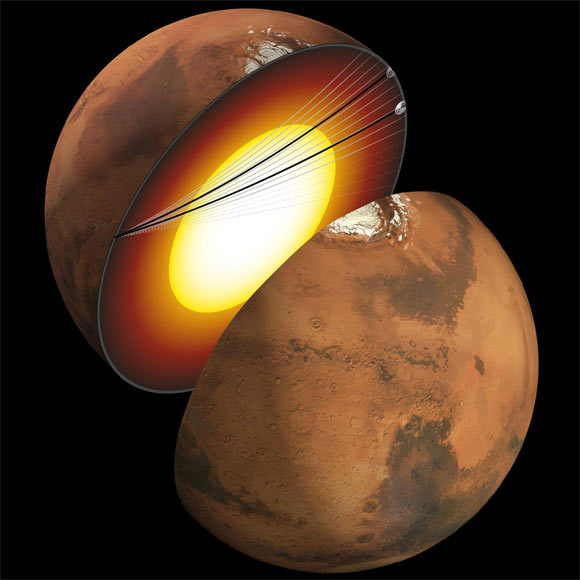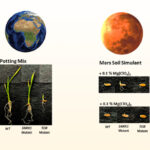Mars has a liquid iron alloy core at its center. Using seismic data gathered by NASA’s InSight lander, planetary scientists have made the first observations of seismic waves traveling through Mars’ liquid iron core.
This artist’s concept shows a cutaway of Mars, along with the paths of seismic waves from two separate marsquakes in 2021. Image credit: NASA / JPL-Caltech / University of Maryland.
“In 1906, scientists first discovered the Earth’s core by observing how seismic waves from earthquakes were affected by traveling through it,” said Dr. Vedran Lekic, a researcher at the University of Maryland.
“More than a hundred years later, we’re applying our knowledge of seismic waves to Mars.”
“With InSight, we’re finally discovering what’s at the center of Mars and what makes Mars so similar yet distinct from Earth.”
On August 25 and September 18, 2021, NASA’s InSight lander detected two marsquakes on the opposite side of the planet — the so-called farside marsquakes.
The distance proved crucial: the farther a quake happens from InSight, the deeper into the planet its seismic waves can travel before being detected.
“We needed both luck and skill to find, and then use, these quakes,” said Dr. Jessica Irving, a researcher at the University of Bristol.
“Farside quakes are intrinsically harder to detect because a great deal of energy is lost or diverted away as seismic waves travel through the planet.”
“The two quakes occurred after the mission had been operating on the Red Planet for well over a full Martian year (about two Earth years), meaning the Marsquake Service — the scientists who initially scrutinize seismographs — had already honed their skills.”
“It also helped that a meteoroid impact caused one of the two quakes; impacts provide a precise location and more accurate data for a seismologist to work with.”
“Because Mars has no tectonic plates, most marsquakes are caused by faults, or rock fractures, that form in the planet’s crust due to heat and stress.”
“The quakes’ size was also a factor in the detections,” she added.
“These two farside quakes were among the larger ones heard by InSight. If they hadn’t been so big, we couldn’t have detected them,” said InSight’s principal investigator Dr. Bruce Banerdt, a researcher at NASA’s Jet Propulsion Laboratory.
“One of the challenges in detecting these particular quakes was that they’re in a shadow zone — a part of the planet from which seismic waves tend to be refracted away from InSight, making it hard for a quake’s echo to reach the lander unless it is very large.”
Detecting seismic waves that cross through a shadow zone is exceptionally difficult; it’s all the more impressive that the InSight team did so using just the one seismometer they had on Mars.
“It took a lot of seismological expertise from across the InSight team to tease the signals out from the complex seismograms recorded by the lander,” Dr. Irving said.
Detecting seismic waves that actually traveled through the core allows scientists to refine their modes of what the core looks like.
Based on the new findings, about a fifth of the core is composed of elements such as sulfur, oxygen, carbon, and hydrogen.
“Determining the amount of these elements in a planetary core is important for understanding the conditions in our Solar System when planets were forming and how these conditions affected the planets that formed,” said Dr. Doyeon Kim, a researcher at ETH Zurich.
“That was always the central goal of InSight’s mission: to study the deep interior of Mars and help scientists understand how all rocky worlds form, including Earth and its Moon.”
The findings were published this week in the Proceedings of the National Academies of Sciences.
_____
Jessica C.E. Irving et al. 2023. First observations of core-transiting seismic phases on Mars. PNAS 120 (18): e2217090120; doi: 10.1073/pnas.2217090120




